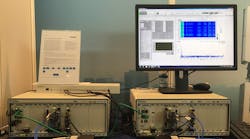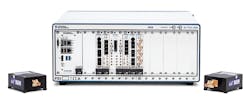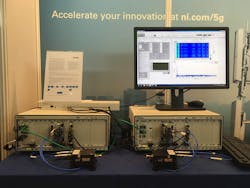Download this article in PDF format.
With the 5G era just barely upon us, it may seem preposterous to already be thinking about 6G communications. However, some are indeed looking ahead to 6G technology, evidenced by National Instruments’ (NI) recent announcement of a sub-terahertz (sub-THz) testbed for 6G research (Fig. 1). Built through a collaboration between NI and Virginia Diodes (VDI), the testbed features NI’s millimeter-wave (mmWave) transceiver system along with radio heads from VDI.
1. This sub-THz testbed for 6G research combines NI’s mmWave transceiver system with Virginia Diodes’ radio heads.
Of course, some might question the legitimacy of any kind of talk surrounding 6G communications—something that NI is keenly aware of. First of all, will we even see 6G anytime soon? And is this new testbed even pertinent to 6G technology? According to Sarah Yost, senior solutions marketing manager, SDR, at NI, “I think 6G is quite far away, but I do think the testbed that we put together for THz and sub-THz research definitely does fall into something that can truly be considered 6G technology.”
With 6G clearly linked to the THz spectrum, it makes sense for VDI to be playing a key role in 6G research—the company is at the forefront of mmWave and THz technology. Yost explains the history between NI and VDI, as well as what prompted NI to investigate the THz realm in the first place. “We’ve worked with VDI for a number of years, and we were looking for an opportunity to collaborate on a larger scale for quite a while.
“Back in 2015, we released our mmWave transceiver system, which has a baseband component, intermediate-frequency (IF) component, and mmWave radio heads. In late 2015, we actually connected some VDI radios to this system for basically a one-off opportunity. But what I noticed is that I started to receive a lot of inquiries concerning what we were doing in terms of THz technology and the 100- to 300-GHz frequency range. With that, we reached out to VDI and were able to get some of the appropriate radios in house.”
After obtaining the VDI radios, NI was able to extend its mmWave technology to even higher frequencies. Yost adds, “We connected VDI’s radios to our mmWave system. So, we were able to reuse the baseband and IF—and I think most importantly, we were able to reuse all of our software IP and use VDI’s radios as the up/downconverters. So, we were able to take a lot of the research that we’d already done in regard to mmWave channel sounding and communication and extend that up in frequency to allow people to start looking at THz and sub-THz and all of the new applications that come with that.”
NI recently demonstrated a 155-GHz channel sounder—the company’s first sub-THz demo—at the recent 5G World Forum (Fig. 2). “It was pretty cool to see that we were able to get all of that set up,” says Yost. “I’m really looking forward to exploring this partnership between NI and VDI and seeing where the research goes as we get into 6G and some of these ‘far-out’ applications and ideas for communications.”
2. NI demonstrated this 155-GHz channel sounder at the 5G World Forum in Dresden, Germany.
As mentioned, the sub-THz testbed features NI’s mmWave transceiver system. Inside the PXI chassis are digital-to-analog converters (DACs) and analog-to-digital converters (ADCs) that connect to field-programmable gate arrays (FPGAs), which is where all of the real-time processing takes place. The local-oscillator (LO) and IF signals are created by a module that connects to the VDI radio heads. The demo at the 5G World Forum featured VDI’s 110- to 170-GHz radio, which was tuned to 155 GHz.
6G Applications?
Yost mentioned the “far-out” applications and ideas associated with 6G. But what exactly are they? She explains, “There are some really cool things that THz technology is going to allow. At the base of all of it is still the idea of communications. If you look at what we’re doing with mmWaves, one application area involves increasing the total throughput possible. THz frequencies actually allow for even wider bandwidths.
“One application area that I’ve seen is very short-range, high-throughput scenarios. The end-use application might be a data center in which you get rid of all of the wires. You’re not necessarily doing long-range communications, but you can have these ultra-high-throughput applications without needing all of the wires. So, that’s maybe one of the more traditional ways that you can think of in regard to how this technology can be used.”
THz technology is also associated with other use cases, such as sensing. Yost adds, “I think one of the more interesting ways people are using THz technology involves incorporating some aspects of sensing into the communications protocol. Airport scanners are one good example. Today, we have these airport scanners, which can very reliably provide detailed information like the different types of fabric we’re wearing, whether we’re carrying any sort of metal, etc. You can actually get a lot of that same information using THz frequencies.
“One example I heard is a company with THz short-range sensing capability that’s using the technology to see the cut position of the plywood. The company can make sure the plywood meets its quality standards and that there’s enough wood versus glue components. You can even extend that and use the technology in food—one of the big applications I’ve heard—in which you can test for allergens as well as contaminants.”
Positioning is another application that could potentially be tied to THz frequencies. Yost explains, “There’s currently an ongoing work item in the standards to make our positioning less reliant on GPS satellites. The goal is to take more advantage of the cellular standards and improve the accuracy. There’s a field of research that’s already looking at extending these frequencies into the THz spectrum to try to achieve positioning with cm-level accuracy.”
To conclude, while we’re not likely to see THz 6G for a long time, companies like NI and VDI are setting out to prove that it’s more than just a pipe dream. Yost sums it up, “I think we’re going to see an uptick in this type of work. I’m excited to see how it goes. THz technology has been pretty unobtainable for a long time. We’re hoping to bring more people into the research community.”



